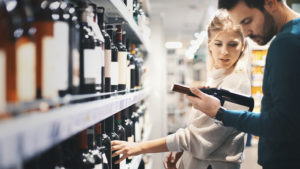In 2015, we published some materials that predicted, in part, that Millennials were a growing segment in the wine market—and that with their entry into the market would come a change in consumer behavior toward brands and the wine experience.
After listening to the Silicon Valley Bank 2017 Wine Report (SVB report for short), I was relieved to hear that we were, by and large, right…. But who’s gloating?
The ways in which Millennials are changing the market are sometimes subtle, so it is easy to miss some of the trends. It might be worthwhile, then, highlighting what is happening…and what forward-thinking wineries are doing about this demographic shift.
The Growing Millennial Market
Looking across generations, Baby Boomers are still the largest segment of U.S. wine consumers, making up 41% of the total market. But their share is declining: Just four years ago, they were 44% of the market. By contrast, both the Millennials and Gen-Xers grew in terms of share of the DTC market. We predicted that their market share would grow over the years and see no reason why this trend would reverse in 2017.
Brand Loyalty
At the 2015 Direct to Consumer, Wine Symposium, we hosted a user group panel on the very subject of Millennials in the market and followed that up with our whitepaper. “Socially, Mobile, Millennials: Farming for the Future User Group.” There we quoted Susan DeMatei, owner of WineGlass Marketing, on brand loyalty across generations:
“We observed that while Baby Boomers would stay attached to a brand once they were familiar with them; [they were] high loyalty (I’m a ‘Chevy’ guy, I’m a ‘GMC’ guy, etc). On the other hand, Millennials have grown up with technology, cable TV, etc. They were born with more choices in everything. ‘They have A.D.D.’ so they are always on the hunt for the next ‘thing’, always.”
These claims were borne out in the SVB report, which noted that “Per capita consumption faces crosscurrents, with retiring wine-loyal baby boomers being replaced by less affluent millennials who seem to be ambivalent about their alcoholic beverage of choice.” This seems to match what we’ve heard elsewhere in the industry, too.
Restaurant Consumption
The SVB report also noted that restaurant consumption of wine was down in 2016. While there are many factors contributing to this, Millennial behavior is part of the story. To quote the SVB report:
“Our frugal millennial consumers don’t want to pay restaurant wine markups. They know they can buy a bottle of wine at the store for less, so in the restaurant, they are more likely to satisfy their consumption needs by starting with a beer or cocktail and having a glass of wine with dinner. More baby boomers are retiring and living on fixed incomes, and that influences their restaurant beverage choices, as well.”
Another sign of the impact from Millennials: Red varietals and blends above $25 were the only growth category for restaurant channels, growing at 1%. These tend to be favored by Millennials, so this growth might be a further indication of Millennials’ rising market power.
Millennials are Experimenting
Another aspect of Millennials that we picked up on was that they experiment. “Millennials are willing to try new things (growlers, wines on tap, etc.). Think of different and new ways of doing things,” says DeMatei.
It appears that Millennials are also demonstrating a willingness to substitute (Craft beer and spirits for wine, for example). They are price conscious and quality conscious more than brand loyal or product loyal.
Remarking on Millennials’ entry into the wine market, the SVB report notes that “millennials are no different [from Baby Boomer or gen-Xers], but they have the added advantage in their formative years of the digital age, which allows them wider selection, better pricing information and greater ease of purchase.” In other words, they are both accustomed to choices and expect good deals. No wonder they experiment.
But this isn’t indicative of an “I’ll try anything” attitude. Patrick Sullivan, a DTC general management executive, told us in 2015 that “Millennials are ‘fantastic testers’ and they will find all flaws in the entire chain (from e-com to receiving of product), so be prepared to address their concerns.” Their experimenting really is testing to see how they can get the best experience for the best price. And as the SVB report notes, “Perfect digital price information in the hands of a thrifty consumer is a nightmare for marketers.”
Some Final Thoughts
The Millennials’ influence on the marketing is small but growing. Baby Boomers still dominate, and so go-to-market tactics still have to work for them. Smart wineries, however, are making changes in anticipation of the growing Millennial market.
What kinds of changes? Here are a few we’re seeing:
More DTC sales channels, and improved experiences surrounding them
- More investment in technology
- Moves to provide a seamless experience between the tasting room and DTC sales
- Better attention paid to packing and packaging
- More concern with “the final mile” of delivery
- Marketing that is crafted around authentic stories
- Much more social media engagement
- Better content curation and sales history tools
If you would like to explore some of these options for your winery—for example, packing ideas, DTC sales, or “the final mile”—contact us. We specialize in craftsmanship fulfillment for the wine industry, and we would love to start a discussion.




